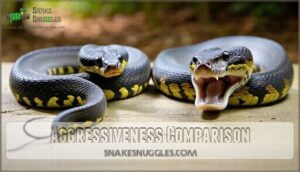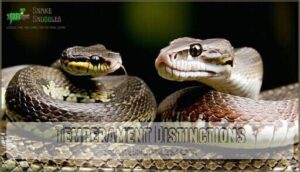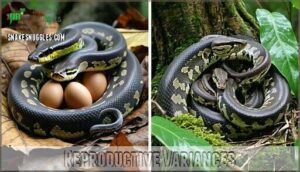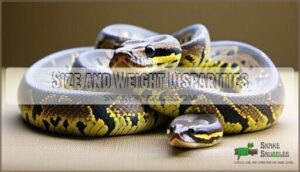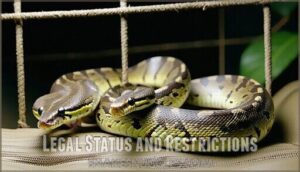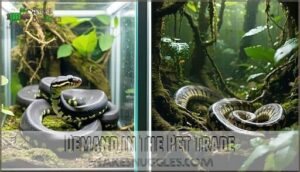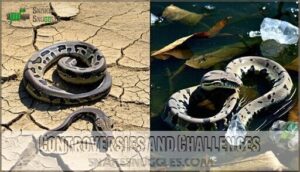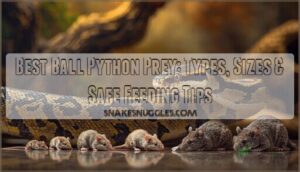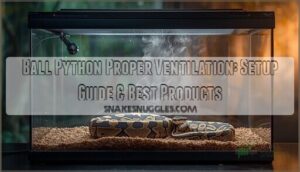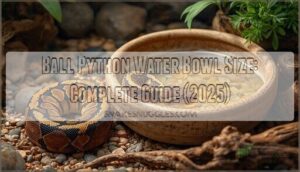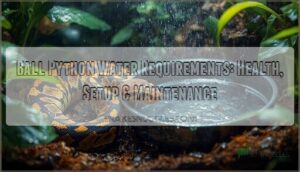This site is supported by our readers. We may earn a commission, at no cost to you, if you purchase through links.
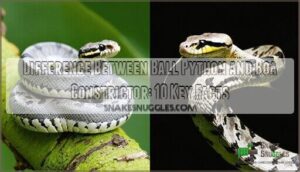
Ball pythons hail from Africa and curl into tight balls when threatened, while boa constrictors call the Americas home.
Pythons lay eggs, but boas give live birth.
You can spot the difference in their heads too – pythons have heat-sensing pits along their lips, while boas typically have fewer or none.
Size-wise, ball pythons stay compact at 3-5 feet, whereas boas stretch 6-10 feet long.
Both make popular pets, yet their care requirements differ substantially.
Understanding these distinctions helps you choose the right serpent companion with complete concepts of their anatomy and origins, and knowing how to care for them is crucial for their well-being, considering their size and heat-sensing pits.
Table Of Contents
- Key Takeaways
- Physical Differences
- Behavioral Variances
- Reproductive Variances
- Environmental Adaptations
- Size and Weight Disparities
- Distinctive Features
- Feeding Habits
- Legal Status and Restrictions
- Demand in The Pet Trade
- Controversies and Challenges
- Frequently Asked Questions (FAQs)
- How to tell if a snake is a boa constrictor?
- Are ball pythons the friendliest snake?
- Is there a difference between ball python and python?
- How to tell a ball python from a boa?
- Are boas more aggressive than ball pythons?
- Is a boa constrictor aggressive?
- Why are ball pythons illegal in Florida?
- How long do ball pythons and boa constrictors live?
- Are ball pythons or boa constrictors better for beginners?
- Can ball pythons and boa constrictors be housed together?
- Conclusion
Key Takeaways
- You’ll easily distinguish these snakes by their origins – ball pythons come from Africa and curl into defensive balls, while boa constrictors hail from the Americas and stay stretched when threatened.
- You’re looking at completely different reproductive methods since ball pythons lay eggs that need external incubation, but boa constrictors give birth to live babies after internal development.
- You’ll need different sized enclosures because ball pythons stay compact at 3-5 feet and 4-5 pounds, while boa constrictors grow much larger at 7-10 feet and can weigh up to 18 pounds.
- You’ll find ball pythons are better for beginners due to their docile temperament and easier handling, whereas boa constrictors require more experience and space but offer a more active, engaging pet experience.
Physical Differences
When you examine a ball python and boa constrictor side by side, several physical differences become immediately apparent.
Scale texture provides the first clue – ball pythons display smoother, more refined scales while boa constrictors feature rougher, more pronounced scaling that feels coarser to touch.
Body shape reveals another distinction. Boa constrictors possess thicker, more muscular builds compared to ball pythons’ sleeker, more streamlined appearance. Head proportions differ substantially too, with boas displaying broader, more triangular heads while ball pythons have more rounded, compact craniums.
Eye color offers another identifying feature. Ball pythons typically showcase striking amber or golden eyes, whereas boa constrictors exhibit eyes ranging from reddish-brown to deep gold. Tail markings also vary between species, with boas often displaying distinctive red coloration earning them the nickname "red-tailed boas."
These snake morphology differences aren’t just cosmetic – they reflect each species’ unique evolutionary adaptations and help distinguish these popular python vs boa specimens in any snake comparison.
Behavioral Variances
When you’re considering these two snake species as pets, you’ll notice ball pythons are much calmer and more docile than boa constrictors.
Boa constrictors tend to be more active, defensive, and require experienced handling, while ball pythons prefer to curl up defensively rather than confront threats.
Aggressiveness Comparison
Neither species wins the aggression contest – both ball pythons and boa constrictors rank low on the snake aggression scale.
Ball pythons show classic defensive behavior by curling into their signature ball, while boa constrictors rely on threat response through hissing and occasional strikes.
Understanding these temperament traits helps reduce handling difficulty and bite frequency incidents.
Here are key aggression factors to examine:
- Ball pythons rarely bite – their go-to move is becoming a living basketball
- Boa constrictors may hiss first – they’re giving you a polite warning
- Both species prefer escape over confrontation – flight beats fight every time
- Stressed snakes show more defensive behavior – proper habitat reduces aggression
- Snake docility increases with regular, gentle handling – familiarity breeds calmness
Temperament Distinctions
Understanding snake temperament helps you choose the right pet for your experience level. Ball pythons showcase remarkable docility levels and handling ease, making them perfect for beginners who want a calm companion.
Boa constrictors display more defensive behavior initially but aren’t truly aggressive. Their activity comparison reveals boas as more curious and energetic, while ball pythons prefer staying still.
Both species develop trust through consistent, gentle interaction.
- Snake docility varies substantially between these two popular species
- Beginner suitability strongly favors ball pythons over boa constrictors
- Snake aggression rarely occurs in either species with proper care
- Snake temperament improves dramatically with regular, patient handling sessions
- Activity comparison shows boas explore more while ball pythons remain stationary
Reproductive Variances
You’ll notice that ball pythons and boa constrictors reproduce in completely different ways, with ball pythons laying eggs while boa constrictors give birth to live young.
This fundamental difference affects their breeding cycles, gestation periods, and the care requirements for their offspring, highlighting the importance of understanding reproduction methods.
Reproductive Methods
Ball pythons and boa constrictors use completely different reproductive methods.
Ball pythons practice oviparous reproduction through egg laying, while boa species give live birth.
During breeding season, ball pythons deposit eggs externally, but boa constrictors retain developing young internally throughout their gestation period.
Courtship rituals often involve males initiating the mating process.
| Species | Reproductive Method | Process |
|---|---|---|
| Ball Python | Oviparous | Egg laying |
| Boa Constrictor | Ovoviviparous | Live birth |
Birthing Processes
Once you understand their reproductive methods, you’ll notice how ball pythons and boa constrictors deliver their babies differently.
Ball python females practice oviparous reproduction, laying clutches of 3-11 leathery eggs that require 55-60 days of careful incubation.
Boa constrictors use ovoviviparous methods, carrying eggs internally before giving live birth to 10-50 babies after 5-8 months gestation.
Key birthing differences include:
- Egg vs. Live delivery methods
- Clutch sizes vary substantially between species
- Parental care differs after birth
Environmental Adaptations
You’ll notice that ball pythons and boa constrictors have adapted to completely different parts of the world, with ball pythons thriving in West and Central Africa’s savannas while boa constrictors dominate Central and South America’s rainforests.
These geographic differences have shaped how each species survives, from the ball python’s preference for dry grasslands to the boa constrictor’s ability to hunt both on land and in water.
Natural Habitats
Looking at where these snakes call home, you’ll find they’re worlds apart. Ball pythons thrive in West African savannas and dry grasslands, using scattered trees for thermoregulation. Boa constrictors prefer South America’s lush rainforests with dense canopy coverage.
| Habitat Factor | Ball Python | Boa Constrictor |
|---|---|---|
| Primary Environment | African savannas | Rainforest canopies |
| Climate Preference | Semi-arid regions | Tropical humidity |
| Shelter Selection | Ground burrows | Tree hollows |
| Water Access | Seasonal pools | Permanent streams |
| Temperature Range | 75-85°F daily | 80-90°F constant |
Habitat overlap remains minimal due to these distinct regional adaptations. To replicate the boa’s environment, consider a rainforest terrarium setup. Climate impact and deforestation threaten both snake habitats, making conservation status increasingly important for ecosystem roles.
Geographic Distribution
These serpents call different continents home, creating a fascinating Old World versus New World split.
You’ll find ball pythons thriving in West and Central Africa’s native habitats, while boa constrictors dominate Central and South America’s rainforests.
Snake geography reveals distinct regional adaptations – pythons evolved in African grasslands, boas in American forests.
Boa constrictors are also invasive in Florida.
Unfortunately, habitat loss threatens both species’ ancestral territories today.
Size and Weight Disparities
When you’re comparing these two popular constrictor species, you’ll notice that ball pythons typically reach 3-5 feet in length and weigh 4-5 pounds.
While boa constrictors grow much larger at 7-10 feet and can weigh 13-18 pounds, with some boa constrictors reaching up to 13 feet in certain subspecies.
You’ll find that female boas generally outweigh female ball pythons by a significant margin.
Length Comparison
When comparing these popular constrictor species, size differences become immediately apparent.
Adult lengths vary dramatically between the two.
Ball pythons maintain a compact profile, with average length ranging from 3-5 feet at maturity.
You’ll find that growth rate slows substantially after their third year.
In contrast, boa constrictors can reach maximum size of 7-13 feet, depending on subspecies and genetics.
Sexual dimorphism plays a role in snake size for both species.
Female ball pythons typically outgrow males by 1-2 feet, while female boas can exceed males by several feet.
This python vs boa comparison reveals that boas generally require larger enclosures and more handling experience.
Your choice between these species should consider available space and your comfort level with different snake weight and length requirements.
Weight Differences
Ball pythons and boa constrictors differ substantially in weight.
Ball pythons average 4-5 pounds, with females slightly heavier. Boa constrictors, however, boast greater body mass, with females reaching 13-18 pounds.
This weight difference impacts care, handling, and enclosure needs.
- Average Weights: Ball pythons are lighter.
- Female Weights: Female boas weigh more.
- Male Weights: Males are smaller in both species.
- Growth Rate: Boas grow faster and bulkier.
Distinctive Features
You’ll notice clear differences in head structure and color patterns when comparing these two popular snake species.
Ball pythons have more rounded snouts and smoother scales, while boa constrictors display tapered heads with rougher, more pronounced scales that create distinct textures.
Head Structure
When examining these serpents up close, you’ll spot key differences in their head anatomy.
Ball python and boa constrictor head structure varies substantially in several ways:
- Skull bones: Ball pythons possess more cranial bones than boa constrictors
- Teeth count: Pythons have additional teeth rows for gripping prey
- Snout shape: Ball pythons feature rounded snouts while boas display more tapered profiles
- Jaw structure: Boa constrictors have wider jaw spans for larger prey consumption
These snake anatomy differences help distinguish between species instantly.
Color Patterns
When distinguishing between these popular constrictors, you’ll notice striking differences in their color patterns and genetic variations.
Ball pythons showcase remarkable pattern uniqueness through extensive color morphs, ranging from classic browns to vibrant yellows, whites, and even designer combinations.
Their scale pigmentation creates intricate geometric designs perfect for camouflage strategies in African grasslands.
Boa constrictors typically display much more subtle patterns with reddish-brown saddle markings over tan bases.
While both species exhibit beautiful snake colors, ball pythons offer greater diversity in snake patterns through selective breeding programs.
Some ball pythons even display a unique grayscale look with the axanthic color morph.
Feeding Habits
You’ll notice significant differences in how these two constrictor species approach their meals, from the size of prey they target to their hunting techniques.
Ball pythons prefer smaller mammals like rodents and birds, while boa constrictors can tackle much larger prey including crocodiles and goats due to their superior size and strength.
Prey Preferences
In regards to prey preferences, these snakes differ substantially in their hunting strategies and dietary needs.
Ball pythons target smaller mammals like mice and rats, reflecting their python diet requirements.
Boa constrictors tackle larger prey including rabbits and birds, showcasing their robust boa diet capabilities.
Both species maintain carnivorous diets, but prey size varies considerably between them in both wild diet and captive feeding scenarios.
Feeding Requirements
Understanding dietary needs helps you make informed decisions when choosing between these reptiles.
Your snake’s feeding frequency and prey size requirements will impact your care routine substantially.
- Prey Size: Boa constrictors handle larger meals than ball pythons
- Feeding Frequency: Ball python diet requires meals every 7-14 days versus boas’ 14-21 days
- Captive Diets: Both thrive on frozen-thawed rodents in captivity
- Wild Diets: Natural python diet includes birds; boa diet focuses on mammals
Many owners purchase pre-killed reptile food for convenience.
Legal Status and Restrictions
You’ll find that legal regulations vary substantially between ball pythons and boa constrictors across different states and countries.
Ball pythons face fewer restrictions than boa constrictors, which are often banned or require special permits due to their larger size and potential as invasive species.
Florida Laws
When considering a ball python or boa constrictor in Florida, you’ll encounter specific permit requirements for legal ownership.
Florida laws classify certain constrictors as invasive species, requiring special authorization. Snake regulations prohibit commercial sales of high-risk reptiles after 2021.
Local ordinances impose release penalties to protect ecosystems. Always verify current Florida laws before purchasing these reptiles.
The state also has specific rules about reptile ownership.
Conservation Efforts
Beyond Florida’s regulatory framework, conservation efforts for both ball python and boa constrictor species address critical challenges.
Habitat preservation programs protect remaining ecosystems from habitat degradation. Captive breeding initiatives maintain genetic diversity while reducing wild collection pressure.
Population monitoring tracks species health, while anti-poaching measures combat illegal trade. Sustainable trade practices help balance conservation with responsible pet ownership demands.
Boa constrictors exhibit ovoviviparous reproduction, giving birth to live young.
Demand in The Pet Trade
You’ll find ball pythons dominate the pet snake market due to their calm temperament and manageable size, making them perfect for beginners.
Boa constrictors attract experienced keepers who want larger, more active snakes, though they require more space and handling expertise, which includes a calm temperament.
Popularity as Pets
Ball pythons consistently rank higher than boa constrictors in pet snake popularity.
Their beginner friendliness makes them ideal starter snakes, while boas demand more experience.
You’ll notice clear differences in their appeal:
- Handling ease: Ball pythons stay calmer during interactions
- Housing needs: Boas require substantially larger enclosures
- Maintenance costs: Ball pythons cost less long-term
Snake pets vary greatly in temperament appeal between species.
Many keepers find ball pythons docile, making them a favorite.
Breeding and Morphs
Pet ownership popularity drives extensive breeding programs for both species.
Ball pythons lead the morph genetics revolution with hundreds of color morphs available, while boa constrictors offer fewer but equally stunning variations.
Snake breeding presents unique breeding challenges, from precise incubation methods to managing genetic diversity.
Hybridization potential exists but remains controversial among ethical breeding advocates.
Many breeders sell unique ball python morphs online.
| Species | Popular Snake Morphs | Breeding Difficulty |
|---|---|---|
| Ball Python | Albino, Piebald, Clown | Moderate |
| Boa Constrictor | Ghost, Sunglow, Motley | Challenging |
| Both | Designer crosses | Advanced |
Controversies and Challenges
When you’re considering these popular pet snakes, you’ll encounter significant debates about their impact on ecosystems and conservation efforts.
Both ball pythons and boa constrictors face challenges from habitat loss, illegal trade, and their potential to become invasive species when released into non-native environments.
Invasive Species Concerns
While both species enjoy popularity as pets, their invasive potential creates serious environmental headaches.
You’ve probably heard about the Everglades crisis, where escaped pythons wreak havoc on native species. Boa constrictors pose similar threats when released into unsuitable habitats.
The ecological impact extends beyond Florida’s borders:
- Established boa populations south of Miami disrupt local food chains
- Ecosystem disruption affects vulnerable wetland communities
- Competition with native predators threatens biodiversity
- Breeding facilities increase escape risks across multiple states
Population control remains challenging once these constrictors establish themselves. Conservation strategies focus on preventing releases rather than managing established populations, since ecosystem impact becomes nearly irreversible.
Conservation Implications
You’ll find conservation status concerns extend beyond invasive species impacts.
Habitat loss and climate change threaten native populations in Africa and South America.
Sustainable trade practices become critical as captive breeding affects genetic diversity.
Wild collection pressures increase ecosystem impact while invasive potential creates management challenges.
Conservation efforts must balance pet trade demands with biodiversity protection.
Frequently Asked Questions (FAQs)
How to tell if a snake is a boa constrictor?
Roughly 60% of snake misidentifications involve confusing boas with pythons.
You’ll spot a boa constrictor by its stockier build, reddish-brown saddle markings, single row of belly scales under the tail, and distinctive reddish tail coloring.
Are ball pythons the friendliest snake?
Ball pythons are among the most docile snakes you’ll encounter.
They’re naturally calm, rarely bite, and handle stress well.
While "friendliest" is subjective, their gentle temperament makes them excellent beginner pets compared to other species, which showcases their gentle nature.
Is there a difference between ball python and python?
Ever wondered if you’re talking about the same snake? Yes, there’s a difference!
Ball pythons are one specific type of python.
You’ll find many python species worldwide, but ball pythons are just one member of this diverse family, and understanding this distinction is key to recognizing the unique characteristics of ball pythons.
How to tell a ball python from a boa?
Check the head shape first – ball pythons have rounded, blunt snouts while boas sport more triangular, pointed heads.
You’ll also notice ball pythons curl into defensive balls, whereas boa constrictors remain stretched out when threatened, and this behavior is a key distinction along with the head shape, including blunt snouts.
Are boas more aggressive than ball pythons?
Generally, boas show more defensive behavior than ball pythons when threatened.
You’ll find ball pythons tend to curl up or hide, while boas are more likely to strike or display aggressive postures when stressed.
Is a boa constrictor aggressive?
Boa constrictors aren’t naturally aggressive toward humans. They’re defensive creatures who’d rather escape than fight. You’ll find they become calmer with regular, gentle handling and proper care from experienced keepers.
Why are ball pythons illegal in Florida?
Ball pythons aren’t actually illegal in Florida.
You can legally own them as pets with proper permits and documentation.
Florida restricts certain python species like Burmese pythons due to invasive population concerns.
How long do ball pythons and boa constrictors live?
You’ll find that ball pythons typically live 20-30 years in captivity, while boa constrictors can reach 25-35 years.
Both species live longer as pets than in the wild due to consistent care and veterinary attention.
Are ball pythons or boa constrictors better for beginners?
Ball pythons are your best choice as a beginner.
They’re smaller, more docile, and easier to handle than boa constrictors.
You’ll find them low-maintenance and forgiving, making them perfect starter snakes.
Can ball pythons and boa constrictors be housed together?
Don’t put all your eggs in one basket—you shouldn’t house ball pythons and boa constrictors together.
They’re different species with unique care needs, temperatures, and stress levels that make cohabitation risky.
Conclusion
Surprisingly, over 4.5 million households in America keep reptiles as pets, with ball pythons and boa constrictors ranking among the most popular choices.
Understanding the difference between ball python and boa constrictor helps you make informed decisions about snake ownership.
Their distinct reproductive methods, geographic origins, size variations, and care requirements create unique challenges for keepers.
Whether you’re drawn to Africa’s compact ball python or the Americas’ larger boa constrictor, proper knowledge guarantees successful snake care and responsible pet ownership.
- https://petkeen.com/are-anacondas-poisonous/
- https://www.reptilesmagazine.com/ball-python-care-sheet/
- https://myfwc.com/wildlifehabitats/nonnatives/regulations/snakes-and-lizards/
- https://public-inspection.federalregister.gov/2015-05125.pdf?1425676516
- https://en.wikipedia.org/wiki/Wildlife_regulations_in_Florida

